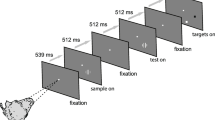Summary
The somatosensory properties of globus pallidus (GP) neurons were assessed in awake restrained cats. Forty-two percent of GP units responded to stimulation of the face. Receptive fields were typically bilateral (49%) or contralateral and 75% included perioral tissue.
Responsive units showed little ability to encode force. In contrast, cells were sensitive to changes in stimulus location within the receptive zone. The majority of cells so tested showed enhanced responding to stimuli applied within the perioral zone.
Many (42%) of the cells which responded to brushing of the guard hairs or vibrissa were directionally sensitive. Of those, 89% showed enhanced responding to stimuli which moved toward the front of the mouth.
These data were discussed in relation to a role of the GP in feedback regulated head positioning movements.
Similar content being viewed by others
References
Dykes RW (1975) Afferent fibers from mystacial vibrissae of cats and seals. J Neurophysiol 38: 650–662
Frank K, Fuortes MGF (1955) Potentials recorded from the spinal cord with microelectrodes. J Physiol (Lond) 130: 625–654
Glotzner RL, Calvin WH (1973) Intracellular recording in cerebral cortex: a method for chronic animals. Electroenceph Clin Neurophysiol 34: 329–330
Harper JA, Labuszewski T, Lidsky TI (1979) Trigeminal influences upon the substantia nigra. Exp Neurol 65: 462–470
Labuszewski T, Lockwood R, McManus F, Edelstein LR, Lidsky TI (1981) The role of postural deficits in oro-ingestive problems caused by globus pallidus lesions. Exp Neurol 74: 93–110
Lidsky TI, Buchwald NA, Hull CD, Levine MS (1975) Pallidal and entopeduncular single unit activity in cats during drinking. Electroenceph Clin Neurophysiol 39: 79–84
Lidsky TI, Robinson JH, Denaro FJ, Weinhold PM (1978) Trigeminal influences on entopeduncular units. Brain Res 141: 227–234
Lidsky TI, Labuszewski T, Avitable M, Robinson JH (1979) The effects of stimulation of trigeminal sensory afferents upon caudate units in cats. Brain Res Bull 4: 9–14
Martin JP (1967) The basal ganglia and posture. Lippincott, Philadelphia
Schneider JS, Lidsky TI (1981) Processing of somatosensory information in striatum of behaving cats. J Neurophysiol 45: 841–851
Schneider JS, Morse JR, Lidsky TI (1981) Pallidal neuronal activity and the control of head movement in cats. Soc Neurosci Abstr 7: 778
Author information
Authors and Affiliations
Additional information
Supported by N.I.N.C.D.S. grant NS 16054
Rights and permissions
About this article
Cite this article
Schneider, J.S., Morse, J.R. & Lidsky, T.I. Somatosensory properties of globus pallidus neurons in awake cats. Exp Brain Res 46, 311–314 (1982). https://doi.org/10.1007/BF00237190
Received:
Accepted:
Published:
Issue Date:
DOI: https://doi.org/10.1007/BF00237190




